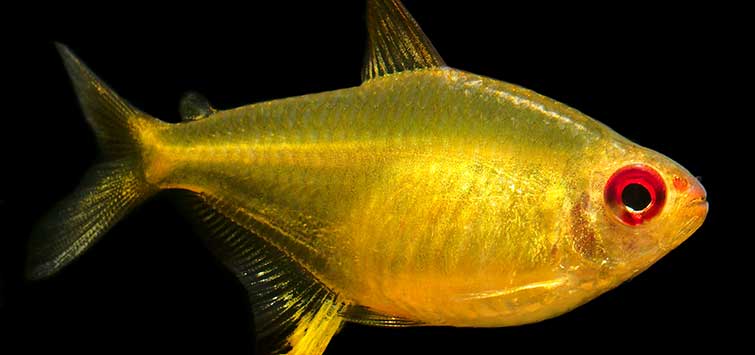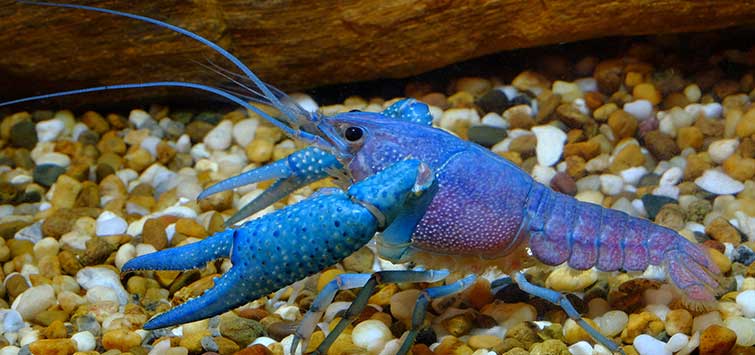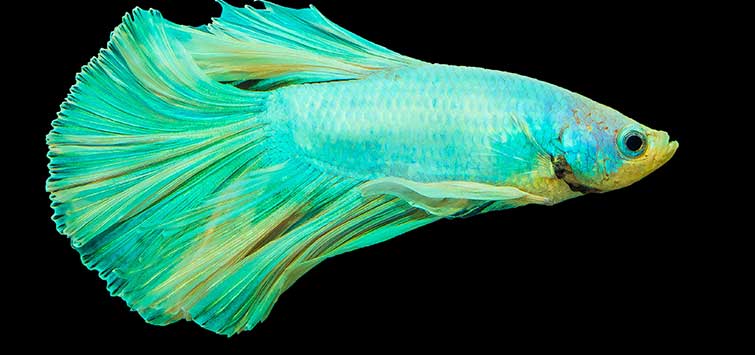Adding Color to the Freshwater Aquarium: Going for Gold
Author: Philip Purser
If you really want to make your aquarium pop, there is nothing like adding a brilliant-yellow fish. One expert hobbyist lists his top yellow choices that are sure to make your aquarium shine.
A Ray of Sunshine
The glowing, sun-like radiance of gold and yellow fish is sure to pop in the freshwater aquarium. Yellow is a common color in some aquariums (perhaps too common in the African cichlid tank), yet getting just the right species of fish to shine its radiant splendor in your aquarium is, perhaps, even more touch-and-go than it is with some other color choices. Yellow species come in the form of peaceful schoolers, as well as sensitive, scaleless loners that require a mature tank and very specific water chemistry parameters. A splash of golden sunshine in an otherwise green or earth-toned aquarium environment can truly be a sight for sore eyes, however.
Best Yellow Fish for Aquariums
Few things are as dramatic as the gilt-finned flash of a gold-nugget pleco swimming past the front of your tank or as eye-catching as a school of lemon tetras, with their canary-yellow finnage shining in golden relief against an earthen background. So, let’s go for gold and discover what species of yellow fish are available for the freshwater community aquarium.
Gold Barb
The first species up for consideration is the gold barb (Puntius semifasciolatus). Native to the Red River in China, the gold barb is, in its naturally occurring coloration, greenish olive and very rarely appears in aquaria. The cultivated form, made popular in the late 1960s, wears a golden color on the body, often with a broken line of high-contrast black speckles running the length of the flanks, and bears yellow or orange finnage.
When healthy and kept under superior water chemistry, the gold barb is a relatively long-lived species. Its lifespan may exceed six years. As a barb (a member of the family Cyprinidae), P. semifasciolatus thrives best when kept in schools. I recommend no fewer than five in a school, though six or more is certainly advantageous to the stress levels and happiness of the fish themselves.
Growing to a maximum length of roughly 3 inches, the gold barb is a peaceful grazer that does well in tanks planted with live vegetation—this species especially likes to graze on algal accumulations in the tank. A mid-level swimmer that seldom sits still, the gold barb is a high-visibility species that, when kept in a school, will definitely add the splash of sunshine to your tank you may be looking for. These very active fish can, indeed, become the dominant species in view at any given time.
Most species of barbs are notoriously tough fish that tend to be tolerant of a very wide range of water chemistries. Maintain the pH from 6.0 to 7.8 and KH at 6.0 to 20.0. Because they can tolerate a wide range of temperatures, these barbs may be kept in either heated or unheated aquaria. Maintain temperatures of 65° to 77°F.
When selecting gold barbs for purchase in pet shops, remember that males (and this is true for most fish species) are considerably smaller and more colorful than females. Bigger specimens are likely to be less attractive in the long run than their smaller counterparts. A school consisting of both sexes is an active, viable, and striking addition to the home aquarium. While they might get a little nippy with elaborately finned species, such as fancy guppies or bettas, these barbs are highly disease resistant and very hardy. As a general rule, you simply can’t go wrong with gold barbs.
Gold Nugget Pleco
If aquarium oddities are your thing and you prefer loner species or non-schooling varieties, look no further than the gold nugget pleco. Gold nugget plecos (Baryancistrus spp.) may actually be one of several closely related fishes. So similar in form, coloration, and life habits are these species that many importers and wholesalers are either unable or unwilling to differentiate. Thus, many hobbyists simply order or describe the gold nugget by the L number they have been assigned, L18 (sometimes L018), as this is how it is imported from South America. Two other forms, L177 and L81 (or L85), are supposed by many to be the same species (or adult or juvenile forms of L18), but, owing to larger or smaller spots on the body and geographically different collection sites, these fish may be considered subspecies or different species altogether. As the plecos are still coming into their own within the worldwide aquarium hobby, more differentiation and classification should accompany these wonderful fish.
As a member of the community tank, the gold nugget pleco is one of the most stunningly gorgeous plecos available. Wearing a base coat of chocolate brown to near black with almost perfectly round yellow to golden spots freckling the entire dorsum and much of the fins, this fish is also adorned with a wide, golden band trimming both the dorsal and caudal fins. Such a bold, striking contrast of coloration makes this peaceful bottom feeder a particularly handsome addition to the home aquarium.
Growing to an adult length of approximately 8 inches, the gold nugget pleco appears in pet shops typically between 2 and 3 inches in size. Know that the 3-inch specimen you purchase today could more than double in size. Also know that this species is an extremely long-lived aquarium fish. Specimens living in excess of 25 years are not unheard of. Unlike many species of plecostomus, which may grow to over two feet in length, this jewel stays small throughout its lifespan. A 30-gallon or larger tank should be enough room for one for its entire life.
Like most plecos, the gold nugget is not a picky eater—both vegetable and meaty fare are taken with relish. Vegetable-based flakes or pleco-specific pellets/flakes work well, as do cubes of freeze-dried brine shrimp or bloodworms. Diet may be supplemented with wheels or wedges of zucchini squash dropped (weighted down, as they tend to float) directly into the tank. Another benefit to adding this brilliantly colored species to your tank is that it is extremely peaceful and will coexist well with virtually any other species that can tolerate the pleco’s water chemistry requirements.
Speaking of water chemistry requirements, this is one of the few drawbacks to keeping this species. It requires warmer water temperatures and softer water than most community tropicals. The gold nugget pleco should be housed under the following conditions: pH 6.7 to 7.5, KH 1.0 to 10.0, and temperatures of 78° to 87°. See what I mean? While many species can mix with the pH requirements of the gold nugget pleco, the low water hardness and very high temperature requirements make for a narrow pool of potential tankmates. South American cichlids and tropicals hailing from the Amazon Basin are great community choices for mixing with the gold nugget pleco.
Golden Swords
Of course, not all the golden and yellow fish on the market are so difficult to acquire. There are plenty of low-priced pet shop staples that can give you the nuclear color blast you’re looking for. The family Poeciliidae has two such species: the swordtails and the fancy guppies. These long-time favorites of both young and old hobbyists alike come in all manner of golds and yellows, and they can easily, and inexpensively, add a solar flare of beauty to your aquarium. Since I’ve already covered fancy guppies in a previous article, I will discuss only the swordtails here, but do note that if your aquarium community is peaceful enough to support them, the fancy guppies are a wonderful choice.
Cousin to the guppies is the swordtail. Hailing from Central America, the swordtail is a wonderful little species that tends to blend very well in the tropical community tank. Drawing its common name from the long, sword-like projection of rays growing on the lower edge of the caudal fin, this species is peaceful and seldom exceeds 5 inches in length. As is typical of community tropicals, the males are the smaller and much more elaborately colored of the two sexes. Sexual dimorphism exists in that the males alone have swords on their tails.
These fish come in both designer and natural colors. Most natural specimens are olive in coloration, while many pet shop varieties have been bred for their golds, yellows, and oranges. Particularly handsome specimens may be a creamy, lemon meringue color with a black-edged sword of the same color. Conversely, I have seen many specimens wearing radiant coats of golden hues highlighted in softer yellows and even silvers. The swordtail is truly an often-unsung beauty in the freshwater world.
Maintain swordtails under water conditions similar to those preferred by guppies. Keep the pH around or just above neutral and the water hardness moderate, with the temperature in the middle to upper 70s.
As is true of the guppies, the swordtails have some special considerations. Tail nippers, such as fish in the family Cyprinidae, can be dangerous tankmates for the swordtails, as these animals may find the flashy yellow swords of your new fish too tempting to pass up. Likewise, the swordtails are prone to ailment. Bacterial infections caused by stress and poor water conditions are common in this species. Such stress may be greatly reduced by providing your fish with aquarium salt. Indeed, all members of the Poeciliidae family fare better in aquariums with some salt in the water. These fish are also sensitive to ammonia spikes and, when stressed, are prone to both bacterial and fungal infection. Swords can be wonderful gold and yellow additions to tanks that are chemically right for their long-term husbandry and care, though they are not as hardy of constitution as barbs or tetras.
Vibrant Tetras
Speaking of tetras, what community tank would be complete without some tetras thrown in? If you’re as much of a tetra lover as I am, there is good news, as this family of fishes definitely has some golden/yellow representatives. Both the lemon tetra and the pristella tetra are yellow species that can add some sunshine to your tank.
Lemon Tetras
By far the more yellow of the two, the lemon tetra (Hyphessobrycon pulchripinnis) is a gorgeous little tetra with a zesty, lemony basal coloration, accented with dorsal and anal fins that are bright yellow and rimmed in black. To make this tetra even more attractive, it comes with bright crimson eyes.
Naturally peaceful and gregarious, the lemon tetra thrives in schools of a half dozen or more. Like most tetras, these fish really show a visible difference in coloration when fed high-protein, color-enhancing flakes. Freeze-dried bloodworms and brine shrimp are also eagerly taken.
One of the only drawbacks to the lemon tetra (tetras, in my opinion, are the perfect tropical community fishes because they have very few drawbacks) is that, when housed singularly or in inadequately small schools, these fish seem to languish away. Their movements will slow, their colors will fade, and their overall vitality will lessen when deprived of schooling tankmates.
Lemon tetras are mid-level swimmers that do best in a planted aquarium with a pH of 6.2 to 7.5, a KH of 5.0 to 24.0, and temperatures of 68° to 78°. Specimens kept under less-than-ideal conditions may appear faded or washed out in color. When housed properly, however, the full splendor of a school of lemon tetras is like the rising sun. Virtually all other non-aggressive, non-predatory species make fine tankmates with the lemon tetra.
Golden Pristella Tetras
A close cousin to the lemon tetra is the golden pristella tetra (Pristella maxillaris). While its bodily coloration is much more subdued than the lemon tetra, the dorsal and anal fins of the golden pristella are, as the name implies, golden flags edged in black and tipped in white. These features make this fish a less gaudy, more subdued flash of radiance within your aquarium.
Growing to a demure maximum length of typically less than 2 inches, this minuscule tetra is, like the lemon tetra, a shoaling species. It is best kept in schools of six or more members. Wild diets include all fry and invertebrates, while a captive diet heavy in bloodworms, brine shrimp, and other such meaty foods is preferred.
Unlike many species of tetra, however, the golden pristella can thrive in a very wide range of pH and water hardness values. Found in both acidic, inland rivers as well as in coastal, semi-brackish estuaries, the golden pristella tetra is one of the most widely adaptable species of community tropical available. This attribute makes this species at home in virtually any community tropical tank. So long as predatory fish cannot eat it, and so long as it is kept in schools of its kindred, the golden pristella tetra can mix well with a very wide range of tankmates.
Other Yellow Options
While there are other species of yellow or golden fish available (some of the gouramis, for example, or the yellow sailfin molly, or the rare and highly sought-after yellow betta), there simply is not enough room to cover them all here. Suffice it to say, golds and yellows can brighten a dark tank, enliven a lackluster tank, and breathe their vibrant, celestial fire into virtually any home aquarium. As I mentioned earlier, if you are a keeper of African cichlids, you may have a hard time getting away from yellows in your tank. Likewise, marine tanks frequently boast of the rich, lemon hues of the tangs. With a little research and effort, the freshwater community tank, too, may come alive with golden hues and yellow flashes.

.png?h=595&iar=0&w=2781&hash=5FD5E69473BCC22199FBFA2FB71B6033)



